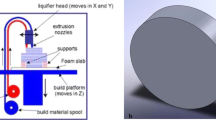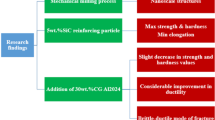Abstract
Aluminium matrix composites (AMCs) have a high strength-to-weight ratio, high stiffness, and good damage resistance under a wide range of operating conditions, making them a viable alternative to traditional materials in a variety of technical applications. Because of their high strength, composite materials are hard to deform to a desired shape and depth at room temperature. As a result, additional treatments are required to enhance the composite’s ductility at room temperature prior to deformation. In this investigation, as-received 6092Al/silicon carbide particle (SiCp) composite sheets (T6-condition) are heat-treated to O-condition annealing to enhance its ductility in order to assess the formability and fracture behaviour of the Al/SiC particle composite sheets under single point incremental forming (SPIF) using different forming parameters at room temperature. The annealed sheets are heat-treated to T6-condition to enhance the strength and achieve properties equivalent to as-received sheet properties. The results demonstrate that the Al/SiC particle composite sheets with T6 treatment could not be deformed to the specified depth due to low ductility at room temperature. Further treatment, such as O-condition annealing, is required to enhance its ductility to enable successful deformation of the Al/SiCp sheets using SPIF. After SPIF processing, the annealed Al/SiCp composite sheets are heat-treated back to T6. The sheets exhibit properties comparable to the as-received sheets. Al/SiC particle composite sheets with low values of SPIF parameters, i.e. small tool diameter, low step size and feed rate, are able to achieve greater formability and fracture depth with low strain hardening under SPIF processing conditions.










Similar content being viewed by others
Availability of data and materials
Data and materials are available.
References
Gatea S, Ou H, McCartney G (2016) Review on the influence of process parameters in incremental sheet forming. Int J Adv Manuf Syst Technol 87(1):479–499
Peng W, Ou H, Becker A (2019) Double-sided incremental forming: a review. J Manuf Sci Eng 141(5)
Zhu H, Ou H, Popov A (2020) Incremental sheet forming of thermoplastics: a review. Int J Adv Manuf Syst Technol p. 1–23
Mishnaevsky L Jr , Derrien K, Baptiste D (2004) Effect of microstructure of particle reinforced composites on the damage evolution: probabilistic and numerical analysis. Compos Sci Technol 64(12):1805–1818
El-Sabbagh AM, Soliman M, Taha MA, Palkowski H (2013) Effect of rolling and heat treatment on tensile behaviour of wrought Al-SiCp composites prepared by stir-casting. J Mater Process Technol 213(10):1669–1681
Mandal D, Viswanathan S (2013) Effect of heat treatment on microstructure and interface of SiC particle reinforced 2124 Al matrix composite. Mater Charact 85:73–81
Gatea S, Chen F, Long H, Ou H (2017) Deformation and fracture of AMC under different heat treatment conditions and its suitability for incremental sheet forming. Procedia Engineering 207:848–853
Mulay A, Ben S, Ismail S, Kocanda A (2017) Experimental investigations into the effects of SPIF forming conditions on surface roughness and formability by design of experiments. J Braz Soc Mech Sci Eng 39(10):3997–4010
Kurra S, Swetha N, Vinodh Reddy C, Regalla SP (2018) Experimental and finite element studies of single stage incremental forming process: effect of process parameters on maximum wall angle and thickness distribution. Adv Mater Process Technol 4(2):322–334
Kumar A, Gulati V, Kumar P, Singh V, Kumar B, Singh H (2019) Parametric effects on formability of AA2024-O aluminum alloy sheets in single point incremental forming. J Market Res 8(1):1461–1469
Nguyen D, Park J, Lee H, Kim Y (2010) Finite element method study of incremental sheet forming for complex shape and its improvement. Proc Inst Mech Eng B J Eng Manuf 224(6):913–924
Mirnia M, Dariani BM, Vanhove H, Duflou J (2014) An investigation into thickness distribution in single point incremental forming using sequential limit analysis. Int J Mater Form 7(4):469–477
Radu M, Cristea I (2013) Processing metal sheets by SPIF and analysis of parts quality. Mater Manuf Process 28(3):287–293
Duflou J, Tunckol Y, Szekeres A, Vanherck P (2007) Experimental study on force measurements for single point incremental forming. J Mater Process Technol 189(1–3):65–72
Hussain G, Gao L, Zhang Z (2008) Formability evaluation of a pure titanium sheet in the cold incremental forming process. Int J Adv Manuf Syst Technol 37(9):920–926
Han F, Mo J-H (2008) Numerical simulation and experimental investigation of incremental sheet forming process. J Cent South Univ Technol 15(5):581–587
Conte R, Ambrogio G, Pulice D, Gagliardi F, Filice L (2017) Incremental sheet forming of a composite made of thermoplastic matrix and glass-fiber reinforcement. Procedia Engineering 207:819–824
Fiorotto M, Sorgente M, Lucchetta G (2010) Preliminary studies on single point incremental forming for composite materials. Int J Mater Form 3(1):951–954
Liu Z, Li G (2019) Single point incremental forming of Cu-Al composite sheets: a comprehensive study on deformation behaviors. Archives of Civil and Mechanical Engineering 19(2):484–502
Al-Ghamdi K, Hussain G (2016) SPIF of Cu/steel clad sheet: annealing effect on bond force and formability. Mater Manuf Process 31(6):758–763
Al-Ghamdi KA, Hussain G (2016) On the comparison of formability of roll-bonded steel-Cu composite sheet metal in incremental forming and stamping processes. Int J Adv Manuf Syst 87(1):267–278
Vahdati M, Sedighi M, Khoshkish H (2010) An analytical model to reduce spring-back in incremental sheet metal forming (ISMF) process. In Adv Mater Res. Trans Tech Publication
Oleksik V, Pascu A, Deac C, Fleaca R, Roman M, Bologa O (2010) The influence of geometrical parameters on the incremental forming process for knee implants analyzed by numerical simulation. in AIP Conference Proceedings. American Institute of Physics
Zhang Z, Zhang H, Shi Y, Moser N, Ren H, Ehmann KF, Cao J (2016) Springback reduction by annealing for incremental sheet forming. Procedia Manufacturing 5:696–706
He A, Kearney MP, Weegink KJ, Wang C, Liu S, Meehan PA (2020) A model predictive path control algorithm of single-point incremental forming for non-convex shapes. Int J Adv Manuf Syst Technol 107(1):123–143
Gatea S, Xu D, Ou H, McCartney G (2018) Evaluation of formability and fracture of pure titanium in incremental sheet forming. Int J Adv Manuf Syst Technol 95(1):625–641
Paul SK (2021) Controlling factors of forming limit curve: a review. Advances in Industrial and Manufacturing Engineering p. 100033
Jeswiet J, Young D (2005) Forming limit diagrams for single-point incremental forming of aluminium sheet. Proc Inst Mech Eng B J Eng Manuf 219(4):359–364
Ham M, Jeswiet J (2007) Forming limit curves in single point incremental forming. CIRP Ann 56(1):277–280
Soeiro J, Silva C, Silva M, Martins P (2015) Revisiting the formability limits by fracture in sheet metal forming. J Mater Process Technol 217:184–192
Davis J (1993) Aluminum and aluminum alloys ASM International. Materials Park
Rashed HM (2018) Control of distortion in aluminium heat treatment. Fundamentals of aluminium Metallurgy. Elsevier, pp 495–524
Younger MS, Eckelmeyer KH (2007) Overcoming residual stresses and machining distortion in the production of aluminum alloy satellite boxes. Sandia National Laboratories
Bikass S, Andersson B, Pilipenko A, Langtangen HP (2013) Spray footprint effect on the induced distortion by the cooling process in the aluminum extrusion process. Appl Therm Eng 57(1–2):14–23
Esmaeilpour R, Kim H, Park T, Pourboghrat F, Agha A, Abu-Farha F (2020) Effect of hardening law and process parameters on finite element simulation of single point incremental forming (SPIF) of 7075 aluminum alloy sheet. Mechanics & Industry 21(3):302
Hill R (1948) A theory of the yielding and plastic flow of anisotropic metals. Proc R Soc A: Math Phys Eng Sci 193(1033):281–297
Bambach M, Hirt G (2005) Performance assessment of element formulations and constitutive laws for the simulation of incremental sheet forming (ISF). In VIII International Conference on Computational Plasticity. Citeseer
Henrard C, Bouffioux C, Eyckens P, Sol H, Duflou J, Van Houtte P, Van Bael A, Duchene L, Habraken A (2011) Forming forces in single point incremental forming: prediction by finite element simulations, validation and sensitivity. Comput Mech 47(5):573–590
Esmaeilpour R, Kim H, Asgharzadeh A, Tiji SAN, Pourboghrat F, Banu M, Bansal A, Taub A (2021) Experimental validation of the simulation of single-point incremental forming of AA7075 sheet with Yld 2004–18P yield function calibrated with crystal plasticity model. Int J Adv Manuf Syst Technol 113(7):2031–2047
Al-Obaidi A, Kräusel V, Landgrebe D (2016) Hot single-point incremental forming assisted by induction heating. Int J Adv Manuf Syst Technol 82(5–8):1163–1171
Gatea S, Ou H, McCartney G (2018) Deformation and fracture characteristics of Al6092/SiC/17.5 p metal matrix composite sheets due to heat treatments. Mater Charact 142:365–376
Kim Y, Park J (2002) Effect of process parameters on formability in incremental forming of sheet metal. J Mater Process Technol 130:42–46
Acknowledgements
The authors would like to express their gratitude to Professor Hui Long and Mr. Jamie Booth of the Department of Mechanical Engineering at the University of Sheffield in the UK for their assistance with the ISF testing.
Author information
Authors and Affiliations
Contributions
Shakir Gatea designed the study, performed experiments and wrote the manuscript; Thana Abdel Salam Tawfiq performed experiments; Hengan Ou funding acquisition, designed the study, review of manuscript and contributed to the data interpretation).
Corresponding authors
Ethics declarations
Ethics approval
Not applicable.
Consent to participate
I am agreeing to participate.
Consent for publication
I am agreeing to publish this work.
Conflict of interest
The authors declare no competing interests.
Additional information
Publisher's Note
Springer Nature remains neutral with regard to jurisdictional claims in published maps and institutional affiliations.
Rights and permissions
About this article
Cite this article
Gatea, S., Tawfiq, T.A.S. & Ou, H. Numerical and experimental investigation of formability in incremental sheet forming of particle-reinforced metal matrix composite sheets. Int J Adv Manuf Technol 120, 1889–1900 (2022). https://doi.org/10.1007/s00170-022-08881-2
Received:
Accepted:
Published:
Issue Date:
DOI: https://doi.org/10.1007/s00170-022-08881-2




